
The Amblycera are a large suborder of chewing lice, parasitic on both birds and mammals. The Amblycera are considered the most primitive suborder of lice.

Gregor Wilhelm Nitzsch was a German classical scholar known chiefly for his writings on Homeric epic.
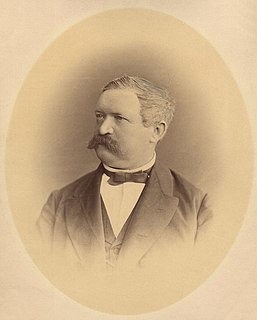
Christoph Gottfried Andreas Giebel was a German zoologist and palaeontologist. He was a professor of zoology at the University of Halle where he managed the zoology collections at the museum. His interests were in systematics and paleontology and he opposed Darwinian evolution. He published several works including Palaozoologie (1846); Fauna der Vorwelt (1847-1856); Deutschlands Petrefacten (1852); Odontographie (1855); Lehrbuch der Zoologie (1857); and Thesaurus ornithologiae (1872-1877).

Christian Ludwig Nitzsch was a German zoologist. He is best remembered for his approach to classifying birds on the basis of their feather tract distributions or pterylosis of their young.
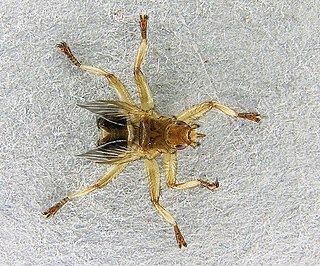
Hippoboscidae, the louse flies or keds, are obligate parasites of mammals and birds. In this family, the winged species can fly at least reasonably well, though others with vestigial or no wings are flightless and highly apomorphic. As usual in their superfamily Hippoboscoidea, most of the larval development takes place within the mother's body, and pupation occurs almost immediately.
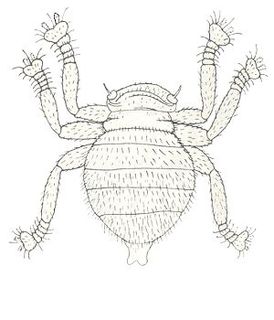
Braulidae, or bee louse, is a family of fly (Diptera) with seven species in two genera, Braula and Megabraula. Found in honey bee colonies, these most unusual wingless and small flies, are not a true bee parasite, and are barely recognizable as Diptera, as they have the superficial appearance of mites or lice.
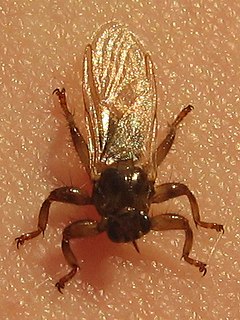
Lipoptena is a genus of Hippoboscidae, known as louse flies or keds.

Braula is a genus of flies (Diptera) in the family Braulidae or bee lice. These are very unusual flies, wingless and flattened, and barely recognizable as Diptera. Braula coeca Nitzsch is a pest of honey bees. The larvae tunnel through the wax honeycomb and the adults are found on the bodies of honey bees. There is some debate as to whether the bee louse causes damage to the honey bee. These flies sometimes can be found at places where bees congregate such as flowers or salt licks, waiting to grab onto hosts from uninfested nests. Braula is cosmopolitan and about 1.6 mm in length.

Karl Wilhelm Nitzsch was a German historian known for his studies of ancient Rome and medieval Germany. He was the son of classical philologist Gregor Wilhelm Nitzsch (1790–1861).
Strigiphilus is a genus of chewing louse in the suborder Ischnocera. It was circumscribed in 1910 by Eric Mjöberg.

Colpocephalum is a genus of chewing louse. Christian Ludwig Nitzsch named the genus in 1818. The Plenary Powers of the International Commission on Zoological Nomenclature selected Colpocephalum zebraBurmeister, 1838 as its type species in the 1950s. There are approximately 135 species in this genus, and they are ectoparasites of birds in at least a dozen different orders.

Rallicola is a genus of chewing louse. It is an ectoparasite of rails and other birds. It was named by Thomas Harvey Johnston and Launcelot Harrison in 1911. There are two subgenera aside from the nominotypical subgenus: Aptericola, whose species are found on kiwi birds, and Huiacola, a monospecific subgenus consisting of Rallicola extinctus, once found on the huia.
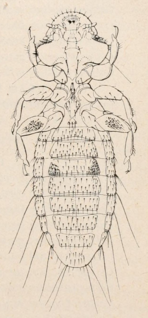
Actornithophilus is a genus of louse in the family Amblycera. It was circumscribed by Gordon Floyd Ferris in 1916. Its species are ectoparasites of birds in the order Charadriiformes.

Quadraceps is a genus of louse. They are ectoparasites of birds in the order Charadriiformes, and the genus was circumscribed in 1939 by Theresa Clay and Richard Meinertzhagen. Infestation is believed to increase the rate of nest desertion, lowers the success rate of baby birds hatching, reduces the number of birds in the clutch, and cause birds to attract fewer mates. All in all, the survival of the nestlings is lowered drastically.
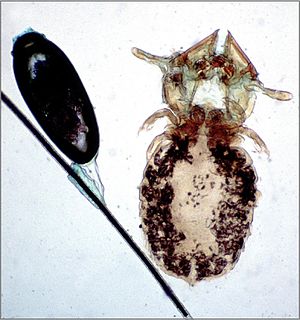
Trichodectidae is a family of louse in the suborder Ischnocera. Its species are parasites of mammals. The following 19 genera are recognized:
Gyropidae is a family of lice in the order Psocodea. There are about 9 genera and more than 90 described species in Gyropidae.
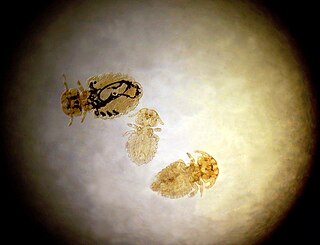
Trichodectes is a genus of louse belonging to the family Trichodectidae.
Myrsidea is a genus of lice belonging to the family Menoponidae. The genus has cosmopolitan distribution.
Naubates is a genus of lice belonging to the family Philopteridae.
Bovicola is a genus of lice belonging to the family Trichodectidae.













